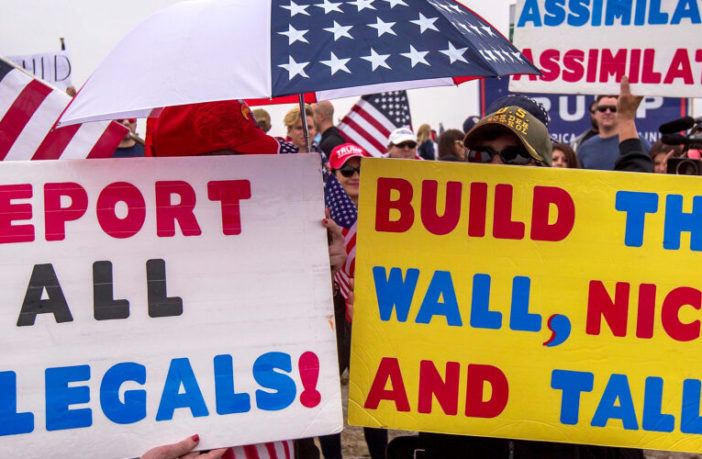You are here: Home / BM / Black Americans, Asian Americans, Mexican Americans and White Americans: Liberty’s Contradiction – America’s Enduring Struggle with Immigration and the Illusion of Inclusion.
Like
Like
Love
Haha
Wow
Sad
Angry
1
(ThyBlackMan.com) The Statue of Liberty stands proudly in Upper New York Bay as a symbol of freedom and a welcoming beacon to the “huddled masses” and “those yearning to be free.” Originally conceived as an emblem of the friendship between the people of France and the United States, it is a sign of their mutual desire for freedom. It was also meant to celebrate the abolition of slavery. People enthusiastically embrace the Statue of Liberty as an iconic symbol of America. Unfortunately, many of the same individuals will refuse to hold the symbol’s deep meaning of compassion, humanity, and inclusion. The U.S. has always maintained a deep anti-immigration sentiment. We want the benefits of the immigrant’s cheap labor, but white supremacy doesn’t always allow the immigrant worker to be accepted as a true American or even as a person with basic human rights.
Chinese immigrants struggled with this double standard during the 1860s. They were able to escape the famine and political turmoil within their homeland to settle on the West Coast of the U.S. After arrival, many were recruited to build the transcontinental railroad system since American laborers showed an unwillingness to do the work. The Chinese laborers were eager to work on the multistate transportation project and did it for lower wages. Overall, the issue of wage reduction and the competition for jobs became a sticking point between anti-Chinese groups and labor unions on one side pitted against the Chinese workers on the other. The increasing hostility and resentment whites developed toward the Chinese ultimately resulted in the Chinese Exclusion Act of 1882, which became the first immigration policy based on race. The law banned skilled and unskilled Chinese workers from entering the United States for 10 years. It was renewed for an additional 10 years and later extended indefinitely. With the flow of cheap Chinese labor slowing to a halt, American labor recruiters turned their attention to the Japanese. The Japanese eventually faced the same fate as the Chinese.
Throughout different eras, the degree of hostility and resentment toward immigrants would often fluctuate. At times, it became aggressive and intense. During other periods, the level died down almost unnoticed. Former President Obama remarked that racial advancement doesn’t proceed in a straightforward-moving line. Instead, moments of progress give way to regressions. The targets of hate and hostility would often change, but an immigrant is still an immigrant. During the late 1800s and early 1900s, when Italians, Greeks, Poles, Hungarians, Slavs, and other European groups arrived in the U.S., they were not considered “white.” Economist Robert F. Forester wrote in 1924, “… in a country where the distinction between white man and Black is intended as a distinction of value…it is no compliment to the Italian to deny him his whiteness, but that actually happens with considerable frequency.”
Today, the U.S. Border Patrol and several states have found themselves overwhelmed by the thousands of migrants coming from Mexico every day. As the U.S. is amid a major immigration crisis, Donald Trump has given the American voters a lot to think about. During a speech at a recent campaign rally in New Hampshire, it was not the first time the Republican frontrunner echoed rhetoric from Adolf Hitler. “When they let – I think the real number is 15, 16 million people into our country – when they do that, we got a lot of work to do. They’re poisoning the blood of our country,” he said of immigrants coming into the United States. “That’s what they’ve done. They’ve poisoned mental institutions and prisons all over the world –not just in South America, not just the three or four countries that we think about, but all over the world. They’re coming into our country, from Africa, from Asia – all over the world. They’re pouring into our country.” Hitler often referenced the words “poison and blood” as he wrote about the Jews in his book Mein Kampf.
In 1988, former President Ronald Reagan signed the Civil Liberties Act, which formally apologized for the internment of Japanese Americans. Later, in 2011, after 129 years, the U.S. Senate apologized for the Chinese Exclusion Act. While advancements have been made in the past by rescinding previous discriminatory laws, Donald Trump fully understands what he is doing by following the Mein Kampf playbook and stoking fear and hatred toward foreigners. Combined with his vow to only be a dictator on “day one,” Trump’s authoritarian rhetoric is giving the voters a preview of what a future Trump administration would entail. In following the model of history’s most notorious dictator, a second Trump presidency will tap into America’s dark anti-immigrant history without addressing the true root causes behind this growing humanitarian crisis. While Trump’s words and behavior are disturbing, what’s more alarming is how it is being received and accepted.
Written by David W. Marshall
Official website; https://davidwmarshallauthor.com/



